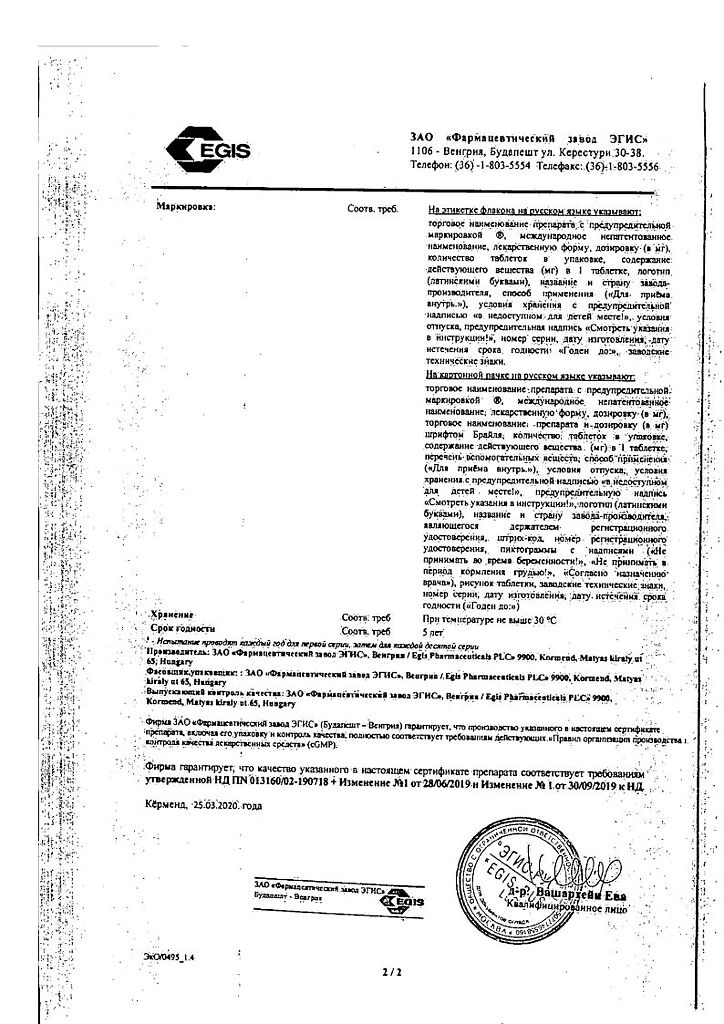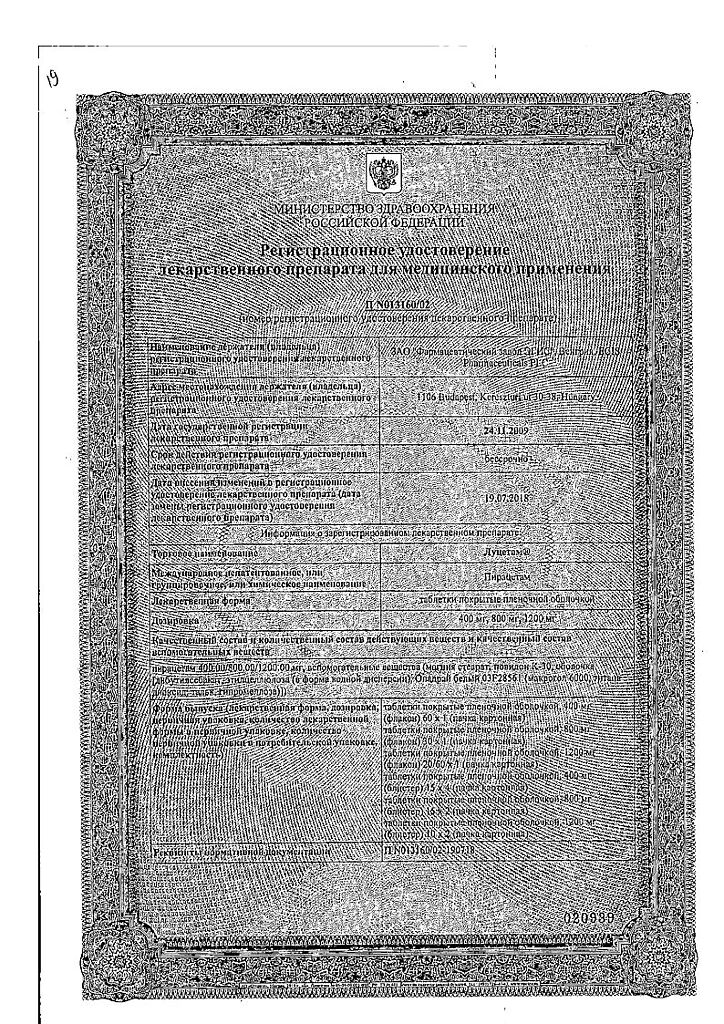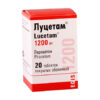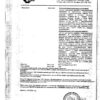No products in the cart.
Lucetam, 1200 mg 20 pcs
€1.00
Out of stock
(E-mail when Stock is available)
Description
Pharmacotherapeutic group: nootropic agent
ATX code: [N06BX03].
Pharmacodynamics
Piracetam is a nootropic that affects the central nervous system in different ways: it modifies neurotransmission in the brain, improves conditions that promote neuronal plasticity, improves microcirculation, affecting blood rheological characteristics without causing vasodilation.
Administration of piracetam in patients with cerebral dysfunction increases attention concentration and improves cognitive functions, which is manifested by significant changes on the electroencephalogram (increased α and β activity, reduced δ activity).
It helps to restore cognitive function due to various disorders such as hypoxia, intoxication or electroconvulsive therapy. Reduces the duration of induced vestibular neuronitis. Piracetam inhibits increased aggregation of activated platelets and, in case of pathological erythrocyte stiffness, improves their deformability and filtration capacity.
Pharmacokinetics
Absorption.
After oral administration, piracetam is rapidly and almost completely absorbed from the gastrointestinal tract. Bioavailability is about 100%. After a single dose of 2 g, maximum concentration (Cmax) is reached within 30 minutes and is 40-60 mcg/ml, after 2-8 hours it is detected in cerebrospinal fluid.
Distribution
The volume of distribution (Vd) is about 0.6 l/kg. It does not bind with plasma proteins. Piracetam penetrates through the blood-brain and placental barriers, as well as hemodialysis membranes. In animal studies it was found that piracetam selectively accumulates in the tissues of the cerebral cortex, mainly in the frontal, parietal and occipital lobes, in the cerebellum and basal nuclei.
Biotransformation
It is not metabolized.
Elimination
The elimination half-life (T1/2) from blood is 4-5 h and 8.5 h for cerebrospinal fluid. T1/2 is prolonged in renal insufficiency. It is excreted unchanged by the kidneys. Renal excretion is almost complete (>95%) within 30 hours. Total clearance of piracetam in healthy volunteers is 86 ml/min.
Indications
Indications
Symptomatic treatment of intellectual-mnestic disorders in the absence of an established diagnosis of dementia.
Reducing the manifestations of cortical myoclonus in patients sensitive to piracetam, both as monotherapy and as part of complex therapy. (In order to determine sensitivity to piracetam in a particular case, a trial course of treatment may be carried out).
Pharmacological effect
Pharmacological effect
Pharmacotherapeutic group: nootropic agent
ATX code: [N06BX03].
Pharmacodynamics
Piracetam is a nootropic that acts on the central nervous system in various ways: it modifies neurotransmission in the brain, improves conditions conducive to neuronal plasticity, improves microcirculation, affecting the rheological characteristics of the blood and without causing vasodilation.
The use of piracetam in patients with cerebral dysfunction increases concentration and improves cognitive function, which is manifested by significant changes in the electroencephalogram (increased α and β activity, decreased δ activity).
Promotes the restoration of cognitive functions due to various disorders, such as hypoxia, intoxication or electroconvulsive therapy. Reduces the duration of induced vestibular neuronitis. Piracetam inhibits increased aggregation of activated platelets and, in the case of pathological rigidity of red blood cells, improves their deformability and filtration ability.
Pharmacokinetics
Absorption.
After oral administration, piracetam is quickly and almost completely absorbed from the gastrointestinal tract. Bioavailability is about 100%. After a single dose of 2 g, the maximum concentration (Cmax) is reached in 30 minutes and is 40-60 mcg/ml, after 2-8 hours it is found in the cerebrospinal fluid.
Distribution
The volume of distribution (Vd) is approximately 0.6 l/kg. Does not bind to plasma proteins. Piracetam penetrates the blood-brain and placental barriers, as well as hemodialysis membranes. In animal studies, it was found that piracetam selectively accumulates in the tissues of the cerebral cortex, mainly in the frontal, parietal and occipital lobes, in the cerebellum and basal ganglia.
Biotransformation
Not metabolized.
Removal
The half-life (T1/2) from the blood is 4-5 hours and 8.5 hours for the cerebrospinal fluid. T1/2 is prolonged in renal failure. It is excreted unchanged by the kidneys. Excretion by the kidneys is almost complete (>95%) within 30 hours. The total clearance of piracetam in healthy volunteers is 86 ml/min.
Special instructions
Special instructions
Due to the effect of piracetam on platelet aggregation, the drug should be prescribed with caution to patients with impaired hemostasis, during major surgical operations, or to patients with symptoms of severe bleeding.
When treating cortical myoclonus, sudden interruption of treatment should be avoided, which may cause resumption of attacks.
During long-term therapy in elderly patients, regular monitoring of renal function indicators is recommended; if necessary, dose adjustment is carried out depending on the results of the QC study.
Penetrates through the filter membranes of hemodialysis machines.
Impact on the ability to drive vehicles and operate machinery
Taking into account possible side effects, the patient should be careful when driving a car and operating machinery.
Active ingredient
Active ingredient
Piracetam
Composition
Composition
1 film-coated tablet contains:
active ingredient:
piracetam – 1200 mg,
excipients:
magnesium stearate 9 mg,
povidone K-30 75 mg;
shell:
dibutyl sebacate 1.82 mg,
ethylcellulose (in the form of aqueous dispersion) 9.1 mg,
opadry white (macrogol 6000 0.65 mg, titanium dioxide 1.95 mg, talc 2.6 mg, hypromellose 9.88 mg).
Pregnancy
Pregnancy
Studies have not been conducted on pregnant women, so piracetam should not be prescribed during pregnancy.
Piracetam penetrates the placental barrier and into breast milk. If you need to use the drug, you should stop breastfeeding.
Contraindications
Contraindications
Individual intolerance to piracetam or pyrrolidone derivatives, as well as other components of the drug.
Huntington’s chorea.
Hemorrhagic stroke.
Severe chronic renal failure (with creatinine clearance (CC) less than 20 ml/min).
Pregnancy and lactation (see Section “Use during pregnancy and lactation”).
With caution
Impaired hemostasis, extensive surgical interventions, severe bleeding, chronic renal failure (with creatinine clearance (CC) 20-80 ml/min).
Side Effects
Side Effects
Nervous system disorders: hyperkinesis, irritability, drowsiness, depression, asthenia: these symptoms more often occur in elderly patients receiving doses above 2.4 g / day; in most cases, it is possible to achieve regression of such symptoms by reducing the dose of the drug. Headache, dizziness, insomnia, mental agitation, anxiety, imbalance, tremor, ataxia, exacerbation of epilepsy, anxiety, hallucinations, confusion, increased libido.
Blood and lymph disorders: bleeding
Immune system disorders: hypersensitivity, including anaphylaxis
Hearing and labyrinth disorders: dizziness (vertigo)
Cardiovascular system disorders: decreased or increased blood pressure.
Digestive system disorders: nausea, vomiting, diarrhea, abdominal pain, epigastric pain.
Metabolic and nutritional disorders: weight gain.
Skin disorders: dermatitis, itching, urticaria.
Allergic reactions: angioedema.
General disorders and disorders at the injection site: pain at the injection site, thrombophlebitis, hyperthermia.
Interaction
Interaction
When used together with thyroid gland extract (triiodothyronine /T3/ + tetraiodothyronine /T4/), increased irritability, disorientation and sleep disturbances are possible. There was no interaction with clonazepam, phenytoin, phenobarbital, or valproic acid.
High doses (9.6 g/day) of piracetam increased the effectiveness of acenocoumarol in patients with venous thrombosis: there was a greater decrease in platelet aggregation, fibrinogen content, von Willibrandt factors, blood and plasma viscosity than when acenocoumarol was prescribed alone.
The possibility of changes in the pharmacodynamics of piracetam under the influence of other drugs is low, since 90% of the drug is excreted unchanged in the urine.
At concentrations of 142, 426, and 1422 mg/ml, piracetam does not inhibit cytochrome P450 isoenzymes (CYP 1A2, 2B6, 2C8, 2C9, 2C19, 2D6, 2E1 and 4A9/11) in vitro. At a concentration of 1422 μg/ml, minimal inhibition of the CYP2A6 isoenzyme (21%) and the 3A4/5 isoenzyme (11%) was observed. However, the inhibition constant (Ki) values are likely to extend well beyond the concentration of 1422 µg/ml. Therefore, metabolic interactions between Priracetam and other drugs are unlikely.
Taking piracetam at a dose of 20 g/day did not affect the maximum concentration and area under the concentration-time curve of antiepileptic drugs in the blood serum (carbamazepine, phenytoin, phenobarbital, valproate) in patients with epilepsy receiving a constant dose.
Co-administration with alcohol did not affect the serum concentration of piracetam and the concentration of alcohol in the blood serum did not change when taking 1.6 g of piracetam.
Overdose
Overdose
Treatment: immediately after taking the drug orally, you can rinse the stomach or induce artificial vomiting. Conducting symptomatic therapy, which may include hemodialysis.
There is no specific antidote. The effectiveness of hemodialysis for piracetam is 50-60%.
Storage conditions
Storage conditions
At 15–30 °C
Shelf life
Shelf life
5 years
Manufacturer
Manufacturer
EGIS, Hungary
Additional information
| Shelf life | 5 years |
|---|---|
| Conditions of storage | At 15-30 °C |
| Manufacturer | EGIS, Hungary |
| Medication form | pills |
| Brand | EGIS |
Related products
Buy Lucetam, 1200 mg 20 pcs with delivery to USA, UK, Europe and over 120 other countries.



















